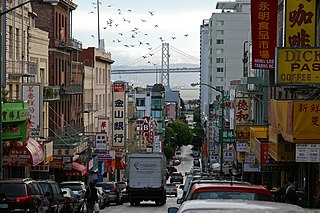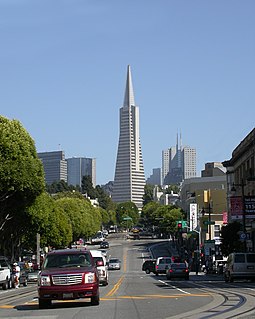The following is a list of streets and alleys that are within or pass through San Francisco's Chinatown. [1] [2] [3]

The following is a list of streets and alleys that are within or pass through San Francisco's Chinatown. [1] [2] [3]

A Chinatown is an ethnic enclave of Chinese people located outside mainland China, Hong Kong, Macau, Singapore or Taiwan, most often in an urban setting. Areas known as "Chinatown" exist throughout the world, including Europe, North America, South America, Asia, Africa and Australasia.

The Chinatown centered on Grant Avenue and Stockton Street in San Francisco, California, is the oldest Chinatown in North America and the largest Chinese enclave outside Asia. It is also the oldest and largest of the four notable Chinese enclaves within San Francisco. Since its establishment in 1848, it has been highly important and influential in the history and culture of ethnic Chinese immigrants in North America. Chinatown is an enclave that continues to retain its own customs, languages, places of worship, social clubs, and identity. There are two hospitals, several parks and squares, numerous churches, a post office, and other infrastructure. Recent immigrants, many of whom are elderly, opt to live in Chinatown because of the availability of affordable housing and their familiarity with the culture. San Francisco's Chinatown is also renowned as a major tourist attraction, drawing more visitors annually than the Golden Gate Bridge.

The Central Subway is an extension of the Muni Metro light rail system under construction in San Francisco, California, from the Caltrain commuter rail depot at 4th and King streets to Chinatown, with stops in South of Market (SoMa) and Union Square.
The Chinatown neighborhood in Oakland, California(Chinese: 屋崙華埠), is traditionally Chinese which reflects Oakland's diverse Chinese American, and more broadly Asian American community. It is frequently referred to as "Oakland Chinatown" in order to distinguish it from nearby San Francisco's Chinatown. It lies at an elevation of 39 feet.

Belden Place is a narrow alley in the Financial District of San Francisco, California that serves as the hub of the city's small French American community.
This is an alphabetical index of topics related to Asian Americans.

The Chinatown in Victoria, British Columbia is the oldest Chinatown in Canada and the second oldest in North America after San Francisco's. Victoria's Chinatown had its beginnings in the mid-nineteenth century in the mass influx of miners from California to what is now British Columbia in 1858. It remains an actively inhabited place and continues to be popular with residents and visitors, many of whom are Chinese-Canadians. Victoria's Chinatown is now surrounded by cultural, entertainment venues as well as being a venue itself. Chinatown is now conveniently just minutes away from other sites of interests such as the Save-On-Foods Memorial Centre, Bay Centre, Empress Hotel, Market Square, and others.

The Chinese Culture Center of San Francisco, California, United States, is a community-based, non-profit organization established in 1965 as the operations center of the Chinese Culture Foundation.
The Adopt-An-Alleyway Youth Empowerment Project is a non-profit project of the Chinatown Community Development Center that is based in the San Francisco Chinatown area.

Jack Kerouac Alley, formerly Adler Alley or Adler Place, is a one-way alleyway in San Francisco, California, that connects Grant Avenue in Chinatown, and Columbus Avenue in North Beach. The alley is named after Jack Kerouac, a Beat Generation writer who used to frequent the pub and bookstore adjacent to the alley.

Columbus Avenue is one of the major streets of San Francisco that runs diagonally through the North Beach and Chinatown areas of San Francisco, California, from Washington and Montgomery Streets by the Transamerica Pyramid to Beach Street near Fisherman's Wharf. This street is home to several notable venues, such as Jack Kerouac Alley, named for poet Jack Kerouac, City Lights Bookstore, Vesuvio Cafe, Specs' Twelve Adler Museum Cafe, and Bimbo's 365 Club.
This is a comprehensive list of lists related to San Francisco. San Francisco is a city in California, within the San Francisco Bay Area.

Rose Lan Pak was a political activist in San Francisco, California, noted for her influence on city politics and power in the Chinatown community. Pak served as a consultant for the San Francisco Chinese Chamber of Commerce and organizer of the Chinese New Year Parade in San Francisco. Although Pak never held an elective political office, she was known as an outspoken, controversial but well-connected "gatekeeper" figure who supported politicians by raising funds and connecting them with the city's growing Asian American community. Her political ties to the Chinese government attracted scrutiny.
This article contains a list of the Chinatowns which are either officially designated neighborhoods or historically important ones in the United States. Many of these Chinatowns were developed in the 1800s by the Chinese diaspora and have served as ethnic Chinese enclaves since then.

The Golden Gate Fortune Cookie Factory is a fortune cookie company with its main entrance off Ross Alley, near Jackson Street in the Chinatown neighborhood of San Francisco, California in the United States. In 2011, Wired voted the company as one of their top ten "geekiest" places in San Francisco.

San Francisco Chinatown: A Guide to Its History & Architecture is a book by Philip Choy, first published in 2012.

Ross Alley is a north–south alley in San Francisco's Chinatown. Ross Alley lies between and is parallel to Stockton and Grant, running one city block between Jackson and Washington.

The Taoist Temple at No. 12 China Alley in Hanford, in Kings County, California, dates from 1893. It was listed on the U.S. National Register of Historic Places (NRHP) in 1972.
As of 2012, 21.4% of the population in San Francisco was of Chinese descent, and at least 150,000 Chinese American residents. The Chinese are the largest Asian American subgroup in San Francisco. San Francisco has the highest percentage of residents of Chinese descent of any major U.S. city, and the second largest Chinese American population, after New York City. The San Francisco Area is 7.9% Chinese American, with many residents in Oakland and Santa Clara County. San Francisco's Chinese community has ancestry mainly from Guangdong province, China and Hong Kong, although there is a sizable population of ethnic Chinese with ancestry from other parts of mainland China and Taiwan as well.
Sexuality, including same-sex sexuality, and other non-normative forms of sexuality have been central to the history of Chinatown, San Francisco. San Francisco's Chinatown, founded in 1848, is the first and largest in the United States. San Francisco was shaped by early Chinese immigrants, who came from the Guangdong province of southern China. These immigrants gathered in the Bay Area in order to join in the California Gold Rush and to build railroads in the American west. San Francisco's Chinatown made room for these early Chinese immigrants to live, and the area turned into a "bachelor society", where female prostitution was pervasive because of the Chinese Exclusion Act. As a racialized immigration region, Chinatown was viewed as an immoral place with the characteristics of "vice", "sluttery" and "sexual deviance" for a long time. These traits were incompatible with the mainstream culture and dominant norms of American society. From the mid-19th century, the state problematized Chinese female prostitution with the subject of sexual transmission, and the government began to go against industrial prostitution in Chinatown, as well as Chinese immigration. As the sex industry grew throughout the Bay Area, the government had to stop the anti-prostitution and anti-immigration law in the beginning of the 20th century. Just like the Castro district and other areas, Chinatown developed its own sexual industries and provided a variety of sexual entertainment to both immigrants and white visitors.
| Wikimedia Commons has media related to Streets and alleys in Chinatown, San Francisco . |